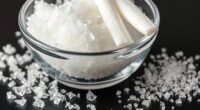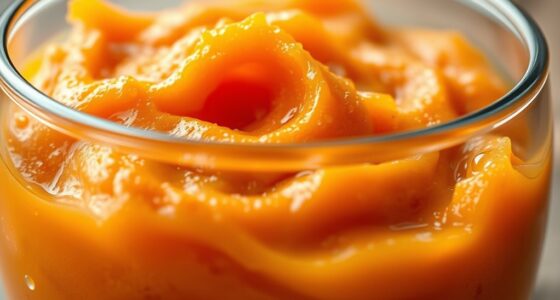You use salt in making ice cream because it lowers the freezing point of ice, which speeds up the cooling process. When salt hits the ice, it creates a brine that stays liquid below 32°F, absorbing heat faster from your mixture. This helps the ice cream freeze more quickly and creates smaller ice crystals, resulting in a smoother texture. Keep exploring to discover how proper salt and ice contact make all the difference in your ice cream success.
Key Takeaways
- Salt lowers the freezing point of water, allowing ice to stay liquid below 32°F, which accelerates ice cream freezing.
- It creates a brine that absorbs heat efficiently, speeding up the cooling process of the ice cream mixture.
- Salt adheres to ice surfaces, promoting even melting and uniform temperature distribution during freezing.
- It encourages the formation of smaller, smoother ice crystals, resulting in a creamier ice cream texture.
- Proper salt and ice contact ensures consistent cooling, preventing uneven freezing and improving final product quality.

Salt plays a crucial role in making ice cream by lowering the freezing point of ice, which allows the mixture to chill more quickly and reach the ideal temperature for freezing. When you add salt to ice, it doesn’t just sit passively; it interacts directly with the ice, affecting how the entire cooling process unfolds. This interaction involves salt adhesion to the surface of ice cubes, which disrupts the normal arrangement of water molecules, preventing them from forming solid ice at the usual temperature. Instead, the salt causes the ice to melt slightly, creating a brine that stays liquid even at temperatures below 32°F (0°C). This brine absorbs heat from the ice cream mixture, speeding up the cooling process and helping you achieve that perfect consistency faster.
As the mixture cools, salt’s influence on ice crystal formation becomes especially important. Normally, when water freezes, it forms large, jagged ice crystals that can give ice cream a coarse texture. But with salt present, the lowered freezing point encourages the formation of smaller, more uniform ice crystals. These tiny crystals are what give ice cream its smooth, creamy mouthfeel. By controlling how the ice crystals develop, salt ensures your ice cream doesn’t turn into a gritty or icy mess. Instead, it stays silky and luscious, with that desirable melt-in-your-mouth quality.
Understanding salt adhesion helps explain why salt is spread evenly over the ice. When you sprinkle salt onto ice cubes in your ice cream maker or bucket, the salt adheres to the surface, creating a thin layer that enhances melting and heat absorption. This adhesion is key to maintaining consistent cooling and preventing uneven freezing. The more evenly the salt coats the ice, the more uniform the temperature drop across the entire mixture, leading to a better-textured ice cream. Without proper salt adhesion, some parts might freeze prematurely or not enough, resulting in an inconsistent texture.
Additionally, the surface area of the ice exposed to salt influences how effectively the mixture cools, making surface contact an important factor in the process.
In essence, salt’s role in ice cream making hinges on its ability to lower the freezing point and influence ice crystal formation. It ensures rapid and even cooling by creating a brine that absorbs heat efficiently and promotes the formation of small, smooth ice crystals. This delicate interplay between salt adhesion, ice melting, and crystal development is what transforms a simple mixture into a velvety, delicious treat. Without salt, the process would be much slower, and the final product wouldn’t have that luxurious, creamy texture you love.
Frequently Asked Questions
Does the Type of Salt Affect the Freezing Process?
You might wonder if the type of salt affects the freezing process. It does, because salt purity and grain size matter. Purity guarantees there’s no unwanted stuff that could interfere, while smaller grains dissolve faster, cooling your mixture more efficiently. Using high-purity, finely-grained salt helps lower the freezing point better, making your ice cream freeze quicker and smoother. So, choose your salt wisely for the best results.
Can Other Substances Be Used Instead of Salt?
You might wonder if other substances can replace salt in making ice cream. For example, in a hypothetical scenario, someone uses calcium chloride as an alternative cooling agent. While salt is effective for lowering the freezing point, salt substitutes like calcium chloride or magnesium chloride can also provide alternative cooling options. These substances help achieve the same result, offering alternative cooling methods that might be more suitable in certain situations.
How Cold Can Homemade Ice Cream Get Without Salt?
Without salt, your homemade ice cream can only get as cold as the ice itself, typically around 0°C (32°F). The ice cream temperature won’t drop much below this because the ice’s melting point stays steady without salt. To achieve colder temperatures, you’d need to increase the ice’s salt concentration, which lowers the melting point and helps the ice cream freeze faster and more solidly.
Is Salt Safe for All Ice Cream Recipes?
You might wonder if salt safety is a concern for all ice cream recipes. Generally, salt is safe for use in ice cream ingredients, but it’s important to avoid excessive amounts. Some recipes, especially those with allergies or sensitivities, may require alternative ingredients. Always check the recipe and use food-grade salt to guarantee safety. If you’re unsure, consult a trusted source or experiment cautiously to keep your ice cream tasty and safe.
How Does Salt Impact the Texture of Ice Cream?
Did you know that adding salt to your ice bath can lower the temperature by up to 21°F? This impacts your ice cream’s texture modification, making it smoother and more uniform. Salt enhances mouthfeel by preventing large ice crystals from forming, resulting in a creamier consistency. By controlling the freezing process, salt helps you achieve the perfect, indulgent ice cream with a richer, more satisfying texture that delights every bite.
Conclusion
So, next time you make ice cream, remember that salt isn’t just a simple ingredient—it’s a magic trick that transforms your freezing mix into creamy perfection. By lowering the freezing point, salt makes ice cold enough to turn liquid into solid faster than you can blink. Without it, your ice cream would stay a soupy mess, and you’d be left dreaming of the ice cream of legends! Salt’s science truly makes your sweet treat possible.










